Detailed Kinematic Analysis Reveals Subtleties of Recovery from Contusion Injury in the Rat Model with DREADDs Afferent Neuromodulation
Abstract
1. Introduction

2. Materials and Methods (Figure 1)
2.1. Experimental Design
2.2. Subjects
2.3. Surgical Procedures
2.4. DRG Injection Surgeries
2.5. Contusion SCI
2.6. Aftercare
2.7. Behavioral Assessment
2.8. Exercise Training
2.9. Kinematic Recordings
2.10. Automatic 2D Marker Tracking Using DeepLabCut
2.11. Three-Dimensional Reconstruction and Kinematic Analyses
2.12. DREADD Activation in Late-Stage Recovery
2.13. Statistical Analyses
3. Results
3.1. Stride Parameters
3.2. Joint Angles (Figure 8)
3.3. Withdrawal of CNO Activation in DREADDs Animals
4. Discussion
4.1. CNO Withdrawal
4.2. Comparison with Prior Hemi-Section Study
4.3. Plasticity
4.4. Potential Confounds
4.5. Future Directions
Author Contributions
Funding
Institutional Review Board Statement
Informed Consent Statement
Data Availability Statement
Acknowledgments
Conflicts of Interest
Abbreviations
| ANOVA | Analysis of Variance |
| ASIS | Anterior superior iliac spine |
| CPG | Central Pattern Generator |
| CNO | Clozapine-N-oxide |
| DLC | DeepLabCut |
| DREADDs | Designer Receptors Exclusively Activated by Designer Drugs |
| DRG | Dorsal root ganglia |
| LME | Linear Mixed Effects |
| MTP | Metatarsophalangeal |
| SCI | Spinal Cord Injury |
References
- Fouad, K.; Tetzlaff, W. Rehabilitative training and plasticity following spinal cord injury. Exp. Neurol. 2012, 235, 91–99. [Google Scholar] [CrossRef]
- Côté, M.-P.; Murray, M.; Lemay, M.A. Rehabilitation Strategies after Spinal Cord Injury: Inquiry into the Mechanisms of Success and Failure. J. Neurotrauma 2017, 34, 1841–1857. [Google Scholar] [CrossRef]
- Waters, R.L.; Adkins, R.H.; Yakura, J.S.; Sie, I. Effect of surgery on motor recovery following traumatic spinal cord injury. Spinal Cord 1996, 34, 188–192. [Google Scholar] [CrossRef] [PubMed]
- Bilchak, J.N.; Caron, G.; Côté, M.-P. Exercise-Induced Plasticity in Signaling Pathways Involved in Motor Recovery after Spinal Cord Injury. Int. J. Mol. Sci. 2021, 22, 4858. [Google Scholar] [CrossRef] [PubMed]
- Rowald, A.; Komi, S.; Demesmaeker, R.; Baaklini, E.; Hernandez-Charpak, S.D.; Paoles, E.; Montanaro, H.; Cassara, A.; Becce, F.; Lloyd, B.; et al. Activity-dependent spinal cord neuromodulation rapidly restores trunk and leg motor functions after complete paralysis. Nat. Med. 2022, 28, 260–271. [Google Scholar] [CrossRef] [PubMed]
- Eisdorfer, J.T.; Smit, R.D.; Keefe, K.M.; Lemay, M.A.; Smith, G.M.; Spence, A.J. Epidural Electrical Stimulation: A Review of Plasticity Mechanisms That Are Hypothesized to Underlie Enhanced Recovery from Spinal Cord Injury with Stimulation. Front. Mol. Neurosci. 2020, 13, 163. [Google Scholar] [CrossRef]
- Lam, T.; Eng, J.J.; Wolfe, D.L.; Hsieh, J.T.; Whittaker, M. A systematic review of the efficacy of gait rehabilitation strategies for spinal cord injury. Top. Spinal Cord Inj. Rehabil. 2007, 13, 32–57. [Google Scholar] [CrossRef]
- Chaplin, E. Functional neuromuscular stimulation for mobility in people with spinal cord injuries. The Parastep I System. J. Spinal Cord Med. 1996, 19, 99–105. [Google Scholar]
- Basso, D.M.; Beattie, M.S.; Bresnahan, J.C. A sensitive and reliable locomotor rating scale for open field testing in rats. J. Neurotrauma 1995, 12, 1–21. [Google Scholar] [CrossRef]
- Ageeva, T.; Sabirov, D.; Sufianov, A.; Davletshin, E.; Plotnikova, E.; Shigapova, R.; Sufianova, G.; Timofeeva, A.; Chelyshev, Y.; Rizvanov, A.; et al. The Impact of Treadmill Training on Tissue Integrity, Axon Growth, and Astrocyte Modulation. Int. J. Mol. Sci. 2024, 25, 3772. [Google Scholar] [CrossRef]
- Cai, J.; Wang, Y.; Zhai, C.; Jiang, K.; Wang, Z.; Fang, L.; Li, X.; Zhu, C.; Liu, W.; Wang, T.; et al. Body weight-supported treadmill training reduces glial scar overgrowth in SCI rats by decreasing the reactivity of astrocytes during the subacute phase. BMC Neurosci. 2025, 26, 30. [Google Scholar] [CrossRef] [PubMed]
- Harkema, S.; Gerasimenko, Y.; Hodes, J.; Burdick, J.; Angeli, C.; Chen, Y.; Ferreira, C.; Willhite, A.; Rejc, E.; Grossman, R.G.; et al. Effect of epidural stimulation of the lumbosacral spinal cord on voluntary movement, standing, and assisted stepping after motor complete paraplegia: A case study. Lancet 2011, 377, 1938–1947. [Google Scholar] [CrossRef] [PubMed]
- Wagner, F.B.; Mignardot, J.-B.; Le Goff-Mignardot, C.G.; Demesmaeker, R.; Komi, S.; Capogrosso, M.; Rowald, A.; Seáñez, I.; Caban, M.; Pirondini, E.; et al. Targeted neurotechnology restores walking in humans with spinal cord injury. Nature 2018, 563, 65–71. [Google Scholar] [CrossRef] [PubMed]
- Kathe, C.; Skinnider, M.A.; Hutson, T.H.; Regazzi, N.; Gautier, M.; Demesmaeker, R.; Komi, S.; Ceto, S.; James, N.D.; Cho, N.; et al. The neurons that restore walking after paralysis. Nature 2022, 611, 540–547. [Google Scholar] [CrossRef]
- Dorrian, R.M.; Berryman, C.F.; Lauto, A.; Leonard, A.V. Electrical stimulation for the treatment of spinal cord injuries: A review of the cellular and molecular mechanisms that drive functional improvements. Front. Cell. Neurosci. 2023, 17, 1095259. [Google Scholar] [CrossRef]
- Choi, E.H.; Gattas, S.; Brown, N.J.; Hong, J.D.; Limbo, J.N.; Chan, A.Y.; Oh, M.Y. Epidural electrical stimulation for spinal cord injury. Neural Regen. Res. 2021, 16, 2367–2375. [Google Scholar] [CrossRef]
- Romeni, S.; Losanno, E.; Emedoli, D.; Albano, L.; Agnesi, F.; Mandelli, C.; Barzaghi, L.R.; Pompeo, E.; Mura, C.; Alemanno, F.; et al. High-frequency epidural electrical stimulation reduces spasticity and facilitates walking recovery in patients with spinal cord injury. Sci. Transl. Med. 2025, 17, eadp9607. [Google Scholar] [CrossRef]
- Courtine, G.; Gerasimenko, Y.; van den Brand, R.; Yew, A.; Musienko, P.; Zhong, H.; Song, B.; Ao, Y.; Ichiyama, R.M.; Lavrov, I.; et al. Transformation of nonfunctional spinal circuits into functional states after the loss of brain input. Nat. Neurosci. 2009, 12, 1333–1342. [Google Scholar] [CrossRef]
- Asboth, L.; Friedli, L.; Beauparlant, J.; Martinez-Gonzalez, C.; Anil, S.; Rey, E.; Baud, L.; Pidpruzhnykova, G.; Anderson, M.A.; Shkorbatova, P.; et al. Cortico-reticulo-spinal circuit reorganization enables functional recovery after severe spinal cord contusion. Nat. Neurosci. 2018, 21, 576–588. [Google Scholar] [CrossRef]
- Roth, B.L. DREADDs for Neuroscientists. Neuron 2016, 89, 683–694. [Google Scholar] [CrossRef]
- Eisdorfer, J.T.; Sobotka-Briner, H.; Schramfield, S.; Moukarzel, G.; Chen, J.; Campion, T.J.; Smit, R.; Rauscher, B.C.; Lemay, M.A.; Smith, G.M.; et al. Chemogenetic modulation of sensory afferents induces locomotor changes and plasticity after spinal cord injury. Front. Mol. Neurosci. 2022, 15, 872634. [Google Scholar] [CrossRef]
- Jacques, S.J.; Ahmed, Z.; Forbes, A.; Douglas, M.R.; Vigenswara, V.; Berry, M.; Logan, A. AAV8(gfp) preferentially targets large diameter dorsal root ganglion neurones after both intra-dorsal root ganglion and intrathecal injection. Mol. Cell. Neurosci. 2012, 49, 464–474. [Google Scholar] [CrossRef]
- Eisdorfer, J.T.; Phelan, M.A.; Keefe, K.M.; Rollins, M.M.; Campion, T.J.; Rauscher, K.M.; Sobotka-Briner, H.; Senior, M.; Gordon, G.; Smith, G.M.; et al. Addition of angled rungs to the horizontal ladder walking task for more sensitive probing of sensorimotor changes. PLoS ONE 2021, 16, e0246298. [Google Scholar] [CrossRef]
- Jendryka, M.; Palchaudhuri, M.; Ursu, D.; van der Veen, B.; Liss, B.; Kätzel, D.; Nissen, W.; Pekcec, A. Pharmacokinetic and pharmacodynamic actions of clozapine-N-oxide, clozapine, and compound 21 in DREADD-based chemogenetics in mice. Sci. Rep. 2019, 9, 4522. [Google Scholar] [CrossRef] [PubMed]
- Nakajima, T.; Ohtori, S.; Inoue, G.; Koshi, T.; Yamamoto, S.; Nakamura, J.; Takahashi, K.; Harada, Y. The characteristics of dorsal-root ganglia and sensory innervation of the hip in rats. J. Bone Jt. Surg. Br. 2008, 90-B, 254–257. [Google Scholar] [CrossRef] [PubMed]
- Akache, B.; Grimm, D.; Pandey, K.; Yant, S.R.; Xu, H.; Kay, M.A. The 37/67-Kilodalton Laminin Receptor Is a Receptor for Adeno-Associated Virus Serotypes 8, 2, 3, and 9. J. Virol. 2006, 80, 9831–9836. [Google Scholar] [CrossRef] [PubMed]
- Krishna, V.; Andrews, H.; Jin, X.; Yu, J.; Varma, A.; Wen, X.; Kindy, M. A Contusion Model of Severe Spinal Cord Injury in Rats. J. Vis. Exp. JoVE 2013, 17, 50111. [Google Scholar] [CrossRef]
- Maghsoudi, O.H.; Tabrizi, A.V.; Robertson, B.; Spence, A. Superpixels based marker tracking vs. hue thresholding in rodent biomechanics application. In Proceedings of the 2017 51st Asilomar Conference on Signals, Systems, and Computers, Pacific Grove, CA, USA, 29 October–1 November 2017; pp. 209–213. [Google Scholar]
- Greene, E.C. Anatomy of the Rat. Trans. Am. Philos. Soc. 1935, 27, ii–vii+ix–xi+1–370. [Google Scholar] [CrossRef]
- Ishikawa, T.; Miyagi, M.; Ohtori, S.; Aoki, Y.; Ozawa, T.; Doya, H.; Saito, T.; Moriya, H.; Takahashi, K. Characteristics of sensory DRG neurons innervating the lumbar facet joints in rats. Eur. Spine J. 2005, 14, 559–564. [Google Scholar] [CrossRef]
- Vulchanova, L.; Schuster, D.J.; Belur, L.R.; Riedl, M.S.; Podetz-Pedersen, K.M.; Kitto, K.F.; Wilcox, G.L.; McIvor, R.S.; Fairbanks, C.A. Differential adeno-associated virus mediated gene transfer to sensory neurons following intrathecal delivery by direct lumbar puncture. Mol. Pain 2010, 6, 31. [Google Scholar] [CrossRef]
- Li, C.; McCloskey, N.S.; Inan, S.; Kirby, L.G. Role of serotonin neurons in the dorsal raphe nucleus in heroin self-administration and punishment. Neuropsychopharmacology 2025, 50, 596–604. [Google Scholar] [CrossRef]
- Pomrenze, M.B.; Giovanetti, S.M.; Maiya, R.; Gordon, A.G.; Kreeger, L.J.; Messing, R.O. Dissecting the Roles of GABA and Neuropeptides from Rat Central Amygdala CRF Neurons in Anxiety and Fear Learning. Cell Rep. 2019, 29, 13–21.e4. [Google Scholar] [CrossRef]
- Pomrenze, M.B.; Tovar-Diaz, J.; Blasio, A.; Maiya, R.; Giovanetti, S.M.; Lei, K.; Morikawa, H.; Hopf, F.W.; Messing, R.O. A Corticotropin Releasing Factor Network in the Extended Amygdala for Anxiety. J. Neurosci. 2019, 39, 1030–1043. [Google Scholar] [CrossRef] [PubMed]
- Hedrick, T.L. Software techniques for two- and three-dimensional kinematic measurements of biological and biomimetic systems. Bioinspir. Biomim. 2008, 3, 034001. [Google Scholar] [CrossRef] [PubMed]
- Mathis, A.; Mamidanna, P.; Cury, K.M.; Abe, T.; Murthy, V.N.; Mathis, M.W.; Bethge, M. DeepLabCut: Markerless pose estimation of user-defined body parts with deep learning. Nat Neurosci. 2018, 21, 1281–1289. [Google Scholar] [CrossRef] [PubMed]
- Nath, T.; Mathis, A.; Chen, A.C.; Patel, A.; Bethge, M.; Mathis, M.W. Using DeepLabCut for 3D markerless pose estimation across species and behaviors. Nat Protoc. 2019, 14, 2152–2176. [Google Scholar] [CrossRef]
- He, K.; Zhang, X.; Ren, S.; Sun, J. Deep Residual Learning for Image Recognition. arXiv 2015, arXiv:1512.03385. [Google Scholar] [CrossRef]
- Insafutdinov, E.; Pishchulin, L.; Andres, B.; Andriluka, M.; Schiele, B. DeeperCut: A Deeper, Stronger, and Faster Multi-Person Pose Estimation Model. arXiv 2016, arXiv:1605.03170. [Google Scholar] [CrossRef]
- Biewener, A.; Patek, S. Animal Locomotion, 2nd ed.; Oxford University Press: New York, NY, USA, 2018; ISBN 978-0-19-874315-6. [Google Scholar]
- Pinheiro, J.; Bates, D.; R-Core. nlme Linear and Nonlinear Mixed Effects Models. R Package Version 3.1-153.—References—Scientific Research Publishing. 2021. Available online: https://www.scirp.org/reference/referencespapers?referenceid=3610088 (accessed on 16 July 2025).
- Prat-Ortega, G.; Ensel, S.; Donadio, S.; Borda, L.; Boos, A.; Yadav, P.; Verma, N.; Ho, J.; Frazier-Kim, S.; Fields, D.P.; et al. Targeted Stimulation of the Sensory Afferents Improves Motoneuron Function in Humans with Spinal Muscular Atrophy. medRxiv 2024. [Google Scholar] [CrossRef]
- Moraud, E.M.; Capogrosso, M.; Formento, E.; Wenger, N.; DiGiovanna, J.; Courtine, G.; Micera, S. Mechanisms Underlying the Neuromodulation of Spinal Circuits for Correcting Gait and Balance Deficits after Spinal Cord Injury. Neuron 2016, 89, 814–828. [Google Scholar] [CrossRef]
- Koditschek, D.E.; Full, R.J.; Buehler, M. Mechanical aspects of legged locomotion control. Arthropod Struct. Dev. 2004, 33, 251–272. [Google Scholar] [CrossRef]
- Rybak, I.A.; Stecina, K.; Shevtsova, N.A.; McCrea, D.A. Modelling spinal circuitry involved in locomotor pattern generation: Insights from the effects of afferent stimulation. J. Physiol. 2006, 577, 641–658. [Google Scholar] [CrossRef]
- Van Steenbergen, V.; Burattini, L.; Trumpp, M.; Fourneau, J.; Aljović, A.; Chahin, M.; Oh, H. Coordinated neurostimulation promotes circuit rewiring and unlocks recovery after spinal cord injury. J. Exp Med. 2022, 220, e20220615. [Google Scholar] [CrossRef]
- Danner, S.M.; Shepard, C.T.; Hainline, C.; Shevtsova, N.A.; Rybak, I.A.; Magnuson, D.S.K. Spinal control of locomotion before and after spinal cord injury. Exp. Neurol. 2023, 368, 114496. [Google Scholar] [CrossRef]

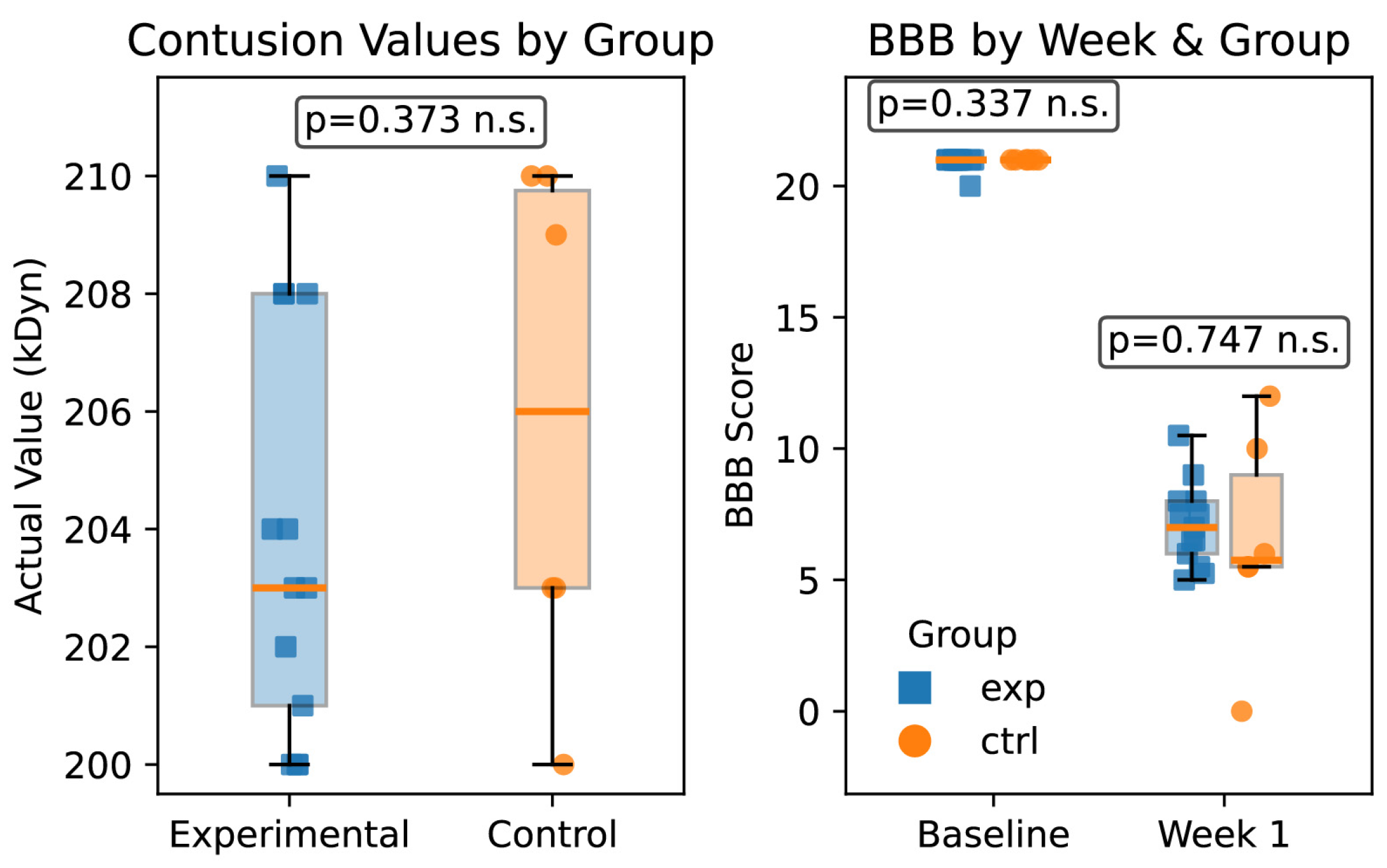
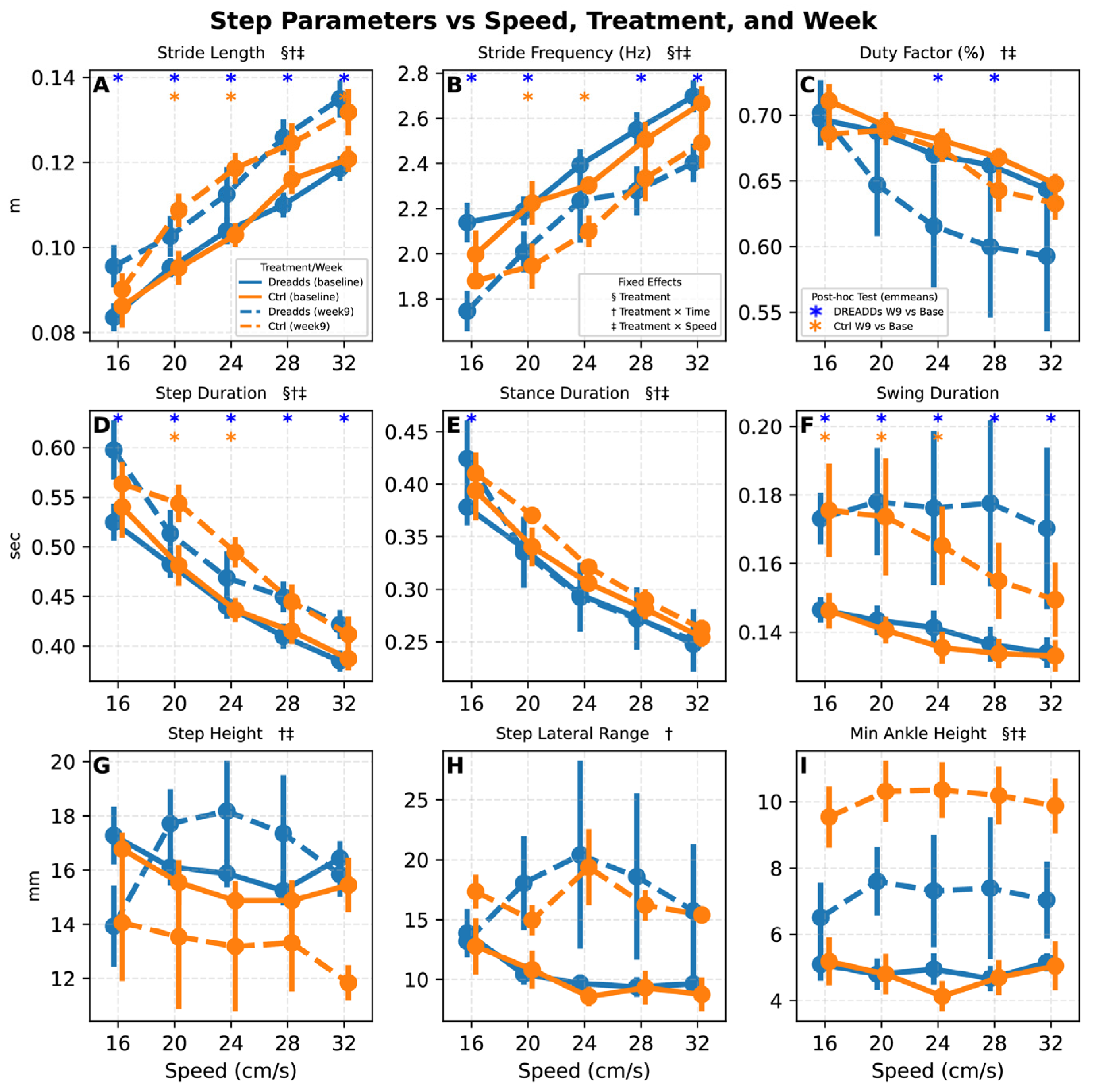

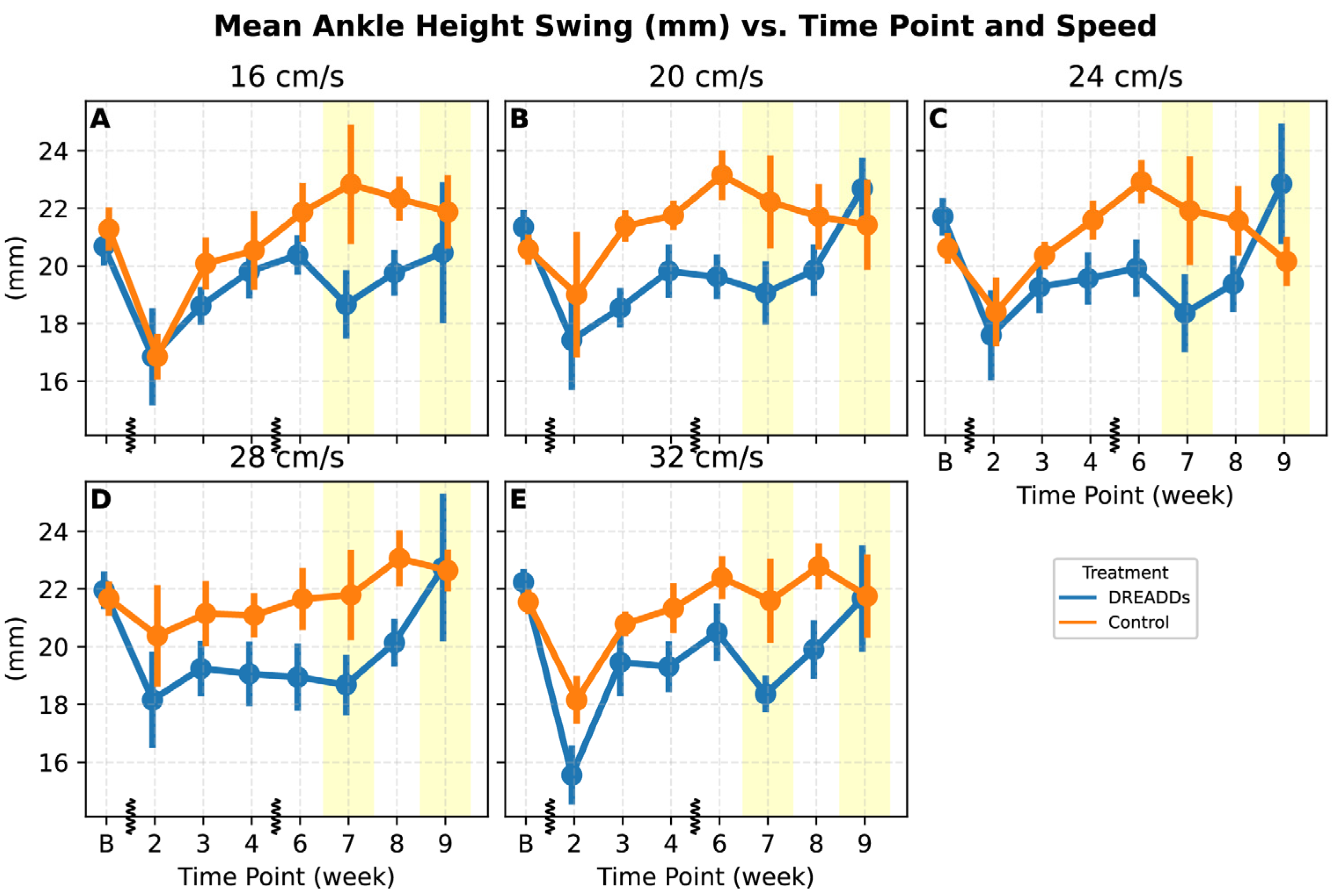
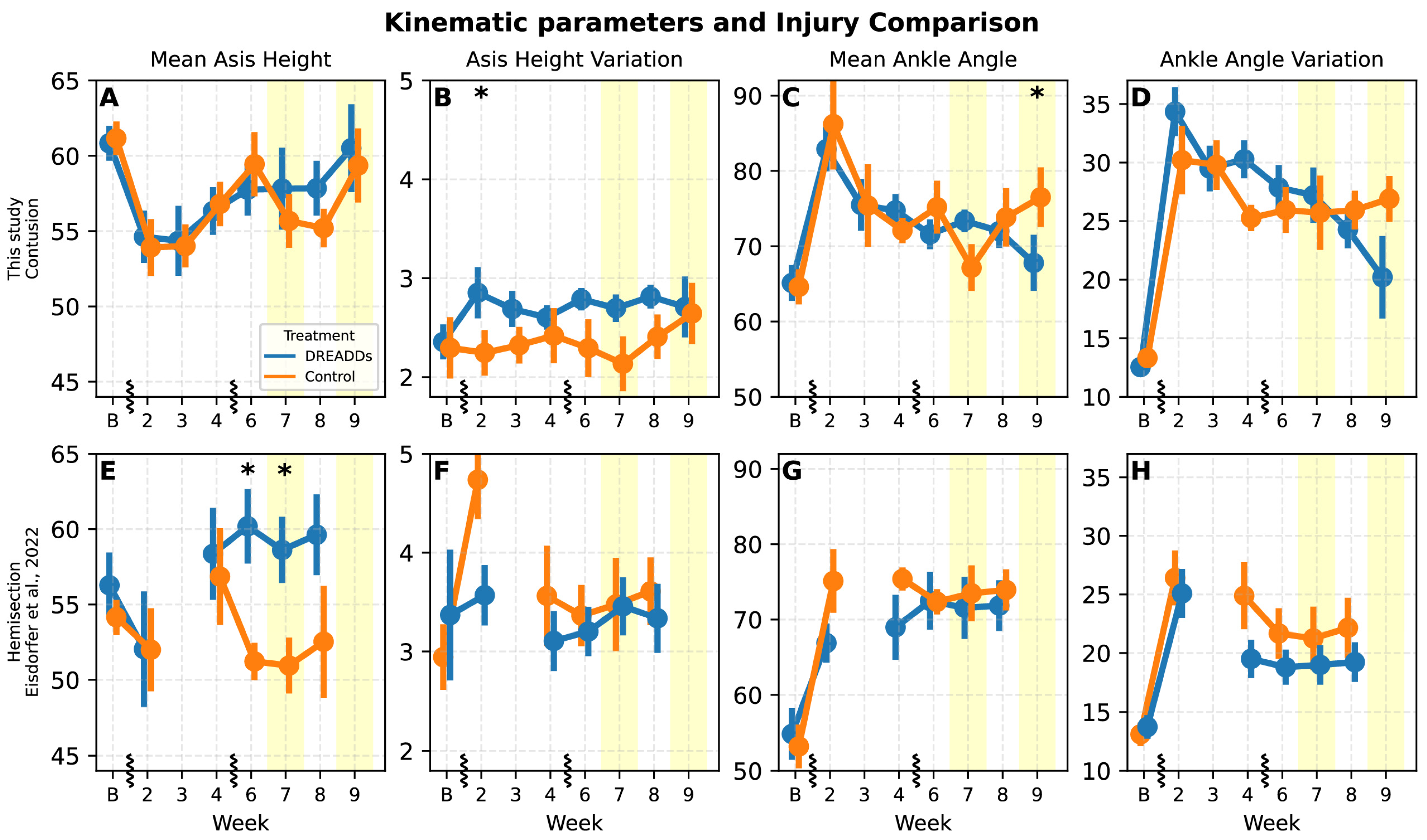
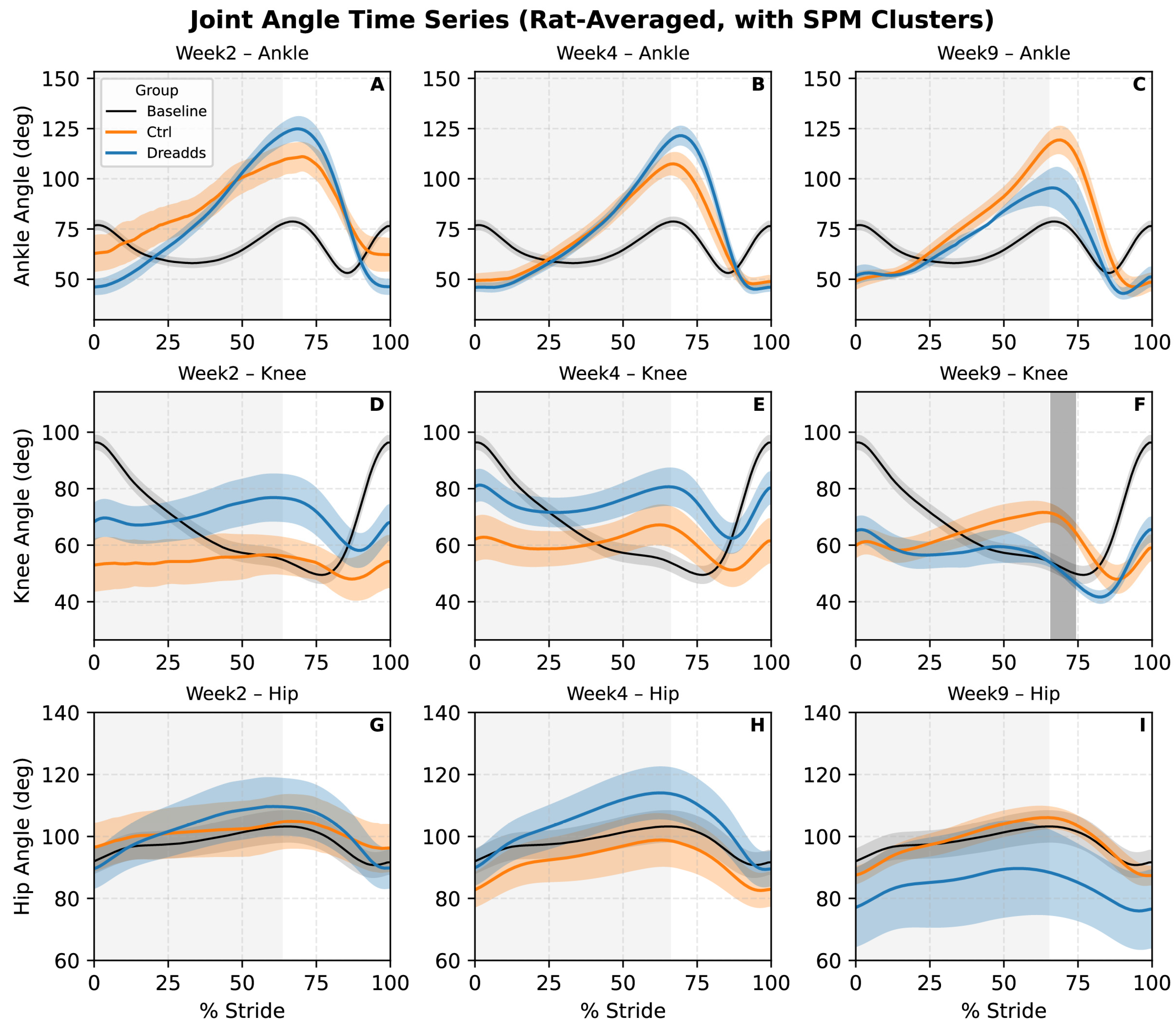
Disclaimer/Publisher’s Note: The statements, opinions and data contained in all publications are solely those of the individual author(s) and contributor(s) and not of MDPI and/or the editor(s). MDPI and/or the editor(s) disclaim responsibility for any injury to people or property resulting from any ideas, methods, instructions or products referred to in the content. |
© 2025 by the authors. Licensee MDPI, Basel, Switzerland. This article is an open access article distributed under the terms and conditions of the Creative Commons Attribution (CC BY) license (https://creativecommons.org/licenses/by/4.0/).
Share and Cite
Koma, G.T.; Keefe, K.M.; Moukarzel, G.; Sobotka-Briner, H.; Rauscher, B.C.; Capaldi, J.; Chen, J.; Campion, T.J., 3rd; Rajavong, J.; Rauscher, K.; et al. Detailed Kinematic Analysis Reveals Subtleties of Recovery from Contusion Injury in the Rat Model with DREADDs Afferent Neuromodulation. Bioengineering 2025, 12, 1080. https://doi.org/10.3390/bioengineering12101080
Koma GT, Keefe KM, Moukarzel G, Sobotka-Briner H, Rauscher BC, Capaldi J, Chen J, Campion TJ 3rd, Rajavong J, Rauscher K, et al. Detailed Kinematic Analysis Reveals Subtleties of Recovery from Contusion Injury in the Rat Model with DREADDs Afferent Neuromodulation. Bioengineering. 2025; 12(10):1080. https://doi.org/10.3390/bioengineering12101080
Chicago/Turabian StyleKoma, Gavin Thomas, Kathleen M. Keefe, George Moukarzel, Hannah Sobotka-Briner, Bradley C. Rauscher, Julia Capaldi, Jie Chen, Thomas J. Campion, 3rd, Jacquelynn Rajavong, Kaitlyn Rauscher, and et al. 2025. "Detailed Kinematic Analysis Reveals Subtleties of Recovery from Contusion Injury in the Rat Model with DREADDs Afferent Neuromodulation" Bioengineering 12, no. 10: 1080. https://doi.org/10.3390/bioengineering12101080
APA StyleKoma, G. T., Keefe, K. M., Moukarzel, G., Sobotka-Briner, H., Rauscher, B. C., Capaldi, J., Chen, J., Campion, T. J., 3rd, Rajavong, J., Rauscher, K., Robertson, B. D., Smith, G. M., & Spence, A. J. (2025). Detailed Kinematic Analysis Reveals Subtleties of Recovery from Contusion Injury in the Rat Model with DREADDs Afferent Neuromodulation. Bioengineering, 12(10), 1080. https://doi.org/10.3390/bioengineering12101080





